
 |
|
|
|
|
#1 |
|
Member
Join Date: Jul 2012
Location: Mother North
Posts: 189
|
Hi everybody,
I’d like to share my new mandau with you all and if possible get some feedback as to the style of carving or anything else that you feel may be of value. I’ve recently focused my interest from the Asmat of New Guinea to Borneo, so I’m trying to learn as much as I possibly can about the cultural background of the Dayak peoples. On to the Mandau, here are the dry specs: Overall length: 73 cm Blade length: 58 cm Thickness at spine: 7 mm It was described by the seller as an Iban Mandau from the mid-20th century. Based on the pre-sale pictures I was a little nervous – particularly about the scabbard: In the pictures, the scabbard patina looked suspiciously like the standard “patina” that I’ve seen applied to “antique” Philipine tourist trinkets. Upon reception however, I was pleased to see that the scabbard has good patina and realistic signs of heavy wear. I now think the scabbard is at least from the same period if not original to the blade. It comes without both the small knife (ilang, right?) and belt attachment, however, as far as I know this is not unheard of concerning 20th century mandaus? The handle is carved from one piece of wood with wound brass thread and tufts of hair like only humans grow them. It seems as if the tufts come from 4 different individuals or at least from 4 different locks. The handle is in very good condition with only minor damage – one of the bottom leeches on one side has broken off, but the damage is very old and now almost invisible. The blade has a fileworked spine and 7 round brass plugs near the tip. Just above the ricasso, the blade is incised with several bands and two additional brass plugs. Although it is hard to see in the image, the spine of the blade is actually not straight, but slightly concave… This puzzles me a bit, as I thought that mandaus by definition had a straight spine, while only jimpuls have a curved one? If anybody could elaborate on this, I would be very grateful! Anyway, I hope you like the photos and I’ll appreciate any input. I wish you all the best of weekends and for those among us celebrating the Eid these days – I wish you an awesome feast too! All the best, - Thor 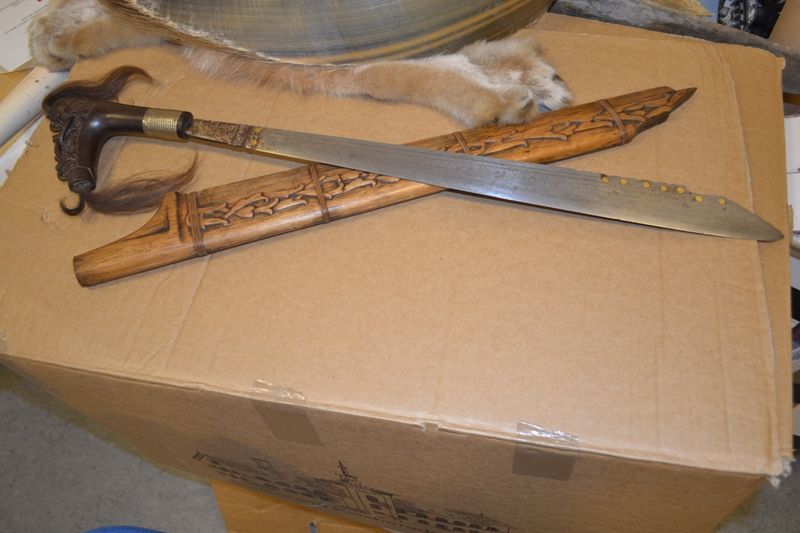 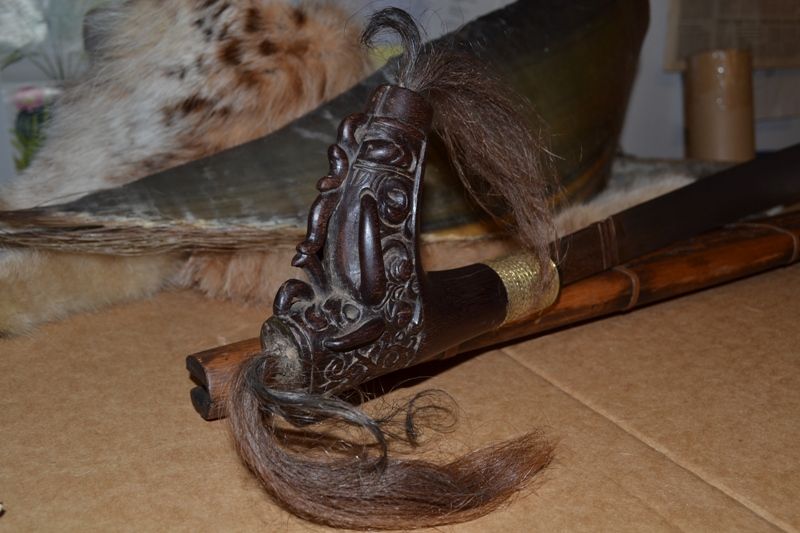 Handle. 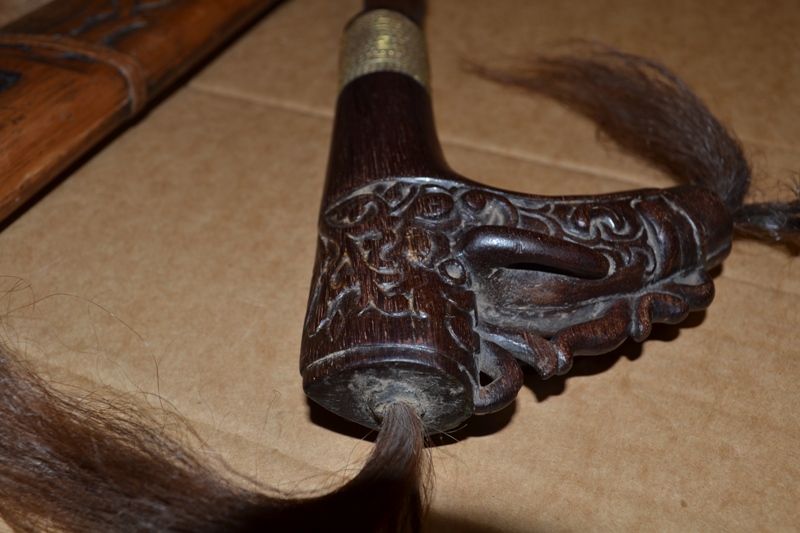 Other side of handle - note broken off leech. 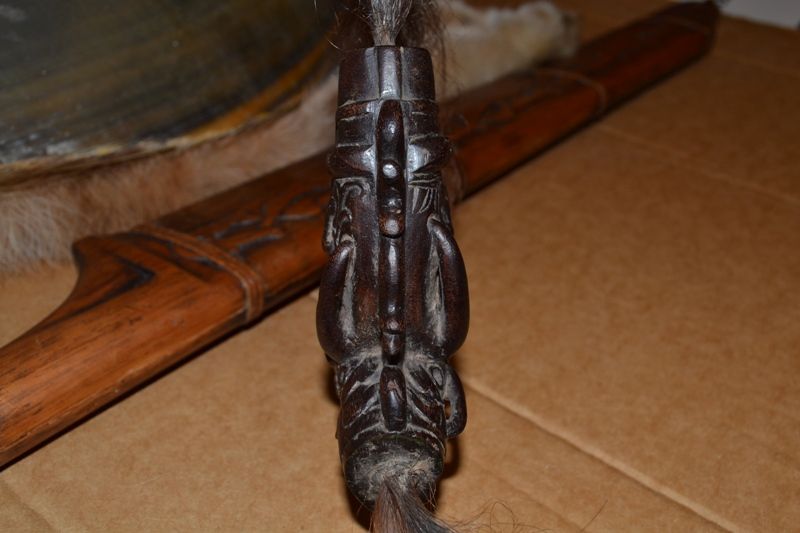 - a candidate for the 'Mandau Face Gallery'? - note broken leech in lower left side. 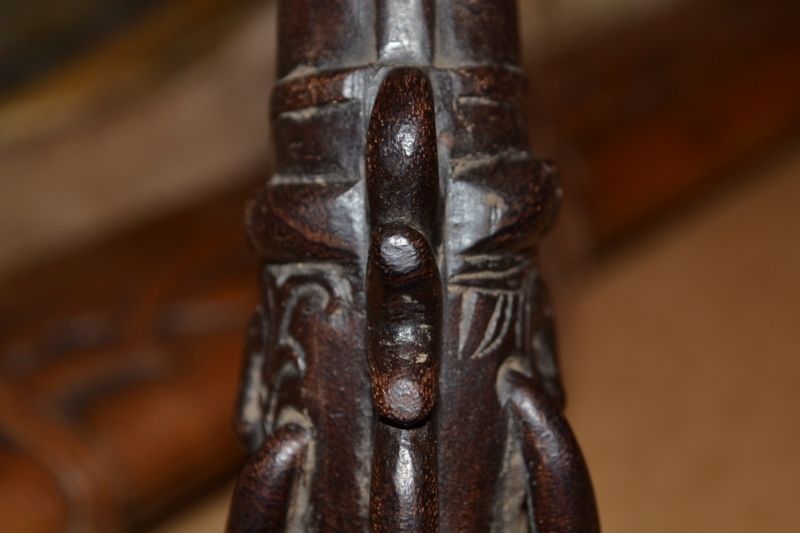 Up close. 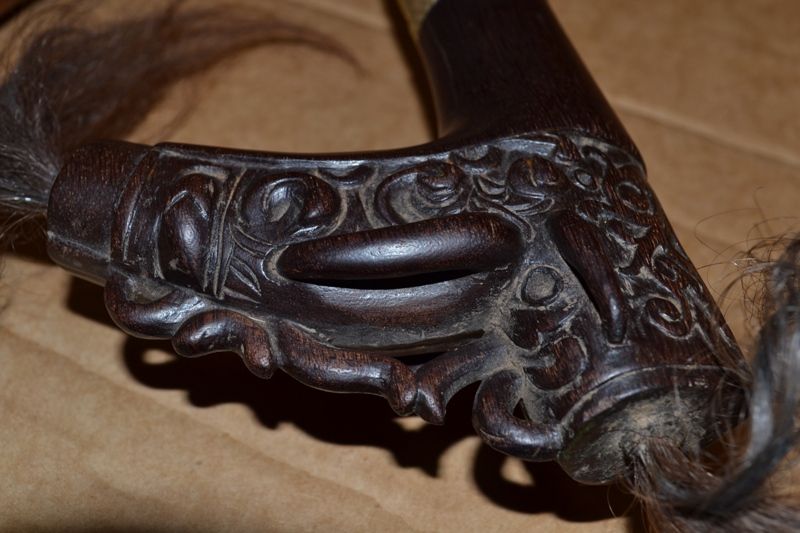 More handle. 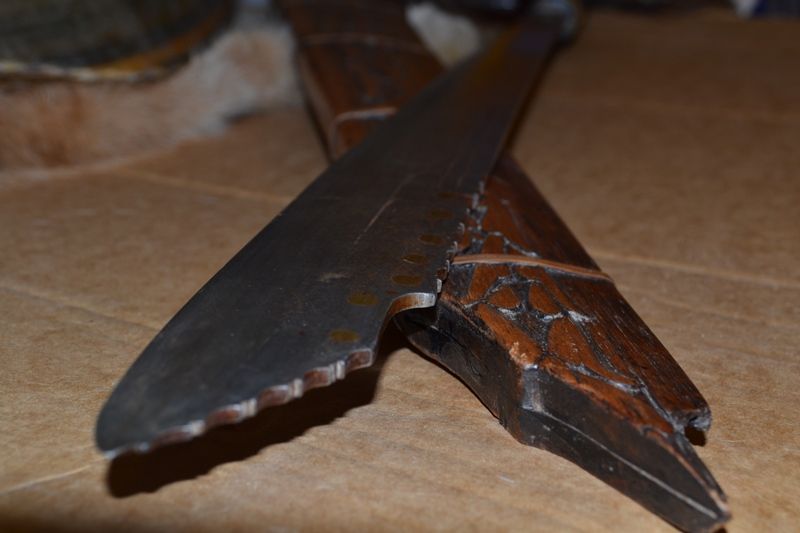 Ends - note brass plugs and broken off scabbard tip. |
|
|

|
|
|
#2 | |||
|
Member
Join Date: Jan 2007
Location: The Netherlands
Posts: 1,462
|
Quote:
It's very difficult to tell something about the style of carvings etc as it can be very complex and there were a lot of different tribes (wether related to eachother or not). The best thing to learn more about this is for instance to use the "search" function on "mandau" in this forum. Some of the best mandaus had been discussed here in the past. Besides that, reading old articles and visits to museums (and databases) are a great resource to learn more about mandaus (However the provenance/origin of the museumpieces aren't described very well often and sometimes even totally wrong, it's good to learn/study the old style as the date of collecting often is noted). But beware digging deep into this matter.... it's very addictive. Another source: http://www.ethnographicswords.com/ As there were many tribes in Borneo, it's not possible to unravel everything and to learn everything known in short time. Even the senior collectors amongst us have difficulties to nail down the exact tribe of mandaus which show up sometimes. I've written a very general (not too long and technical) article about mandaus , which suits reading and studying perfectly for collectors who are trying to learn more about mandaus in general. However there's one problem....... I wrote it in Dutch and have no time (and not liking at the moment) to give it a proper translation into English...... Quote:
Both handle and scabbard don't raise the feeling to me of good patina and signs of wear. The blade is another story. It looks older as the "dress". Maybe you can post an image of the decoration (if there is any) on the shoulder of the blade? (between the handle and the cutting edge of the blade). Quote:
As a rule you can call a Borneo sword a mandau when it's concave at the innerside and convex at the outside (according specific tribes called "parang ilang", "malat" or "baieng"). Maurice |
|||
|
|

|
|
|
#3 |
|
(deceased)
Join Date: Dec 2004
Location: OKLAHOMA, USA
Posts: 3,138
|
THE HANDLE ON YOUR EXAMPLE IS A TRADITIONAL FORM I HAVE SEEN BEFORE BUT THE CARVING ON THE SCABBARD IS ONE I HAVE NOT SEEN.
A CLOSE UP ON THE FORTE OF THE BLADE MAY BE HELPFUL FOR IDENTIFICATION IF IT HAS ANY DESIGN OR CARVING , IF ITS JUST RUST NO PICTURE IS NEEDED. A CLOSEUP OF THE WIRE WRAP COULD HELP TO DETRERMINE IF ITS NEW OR OLD AND A CLOSEUP OF THE SCABBARD CARVING MAY BE OF USE TOO. THE BLADE LOOKS TO BE A GOOD HEAVY ONE IN A PROPER MANDAU FORM. NOT MUCH HELP BUT THEN I AM JUST A BEGINNER ONLY BEEN COLLECTING THEM FOR 30 YEARS OR SO  AS FAR AS DAYAK WEAPONS ARE CONCERNED THATS A BEGINNER UNLESS THAT IS YOUR ONLY INEREST AND YOU SEARCH TIRELESLY FOR INFORMATION. AS FAR AS DAYAK WEAPONS ARE CONCERNED THATS A BEGINNER UNLESS THAT IS YOUR ONLY INEREST AND YOU SEARCH TIRELESLY FOR INFORMATION.
|
|
|

|
|
|
#4 |
|
Member
Join Date: Jul 2012
Location: Mother North
Posts: 189
|
Hi guys and thanks for your feedback!
Maurice, yes, this forum is packed with good threads on Bornean blades and I'm all over them already!  Your site is also really nice, and I've had much pleasure from Roth's text - thank you for making that available! I would also LOVE to receive a copy of your article - even though its in Dutch. - I don't know if you've ever talked to a Dane while drunk, but I can assure you that Danish and Dutch are actually quite understandable if in writing or if both parties speak slow. Your site is also really nice, and I've had much pleasure from Roth's text - thank you for making that available! I would also LOVE to receive a copy of your article - even though its in Dutch. - I don't know if you've ever talked to a Dane while drunk, but I can assure you that Danish and Dutch are actually quite understandable if in writing or if both parties speak slow.  - I have plenty of academic articles to trade with, let me know if you're looking for something in particular! - I have plenty of academic articles to trade with, let me know if you're looking for something in particular!Vandoo, thank you for your input - I really appreciate it! I know what you mean and I think we have similar outlooks on life: I've been going to school for the last 24 years now and I feel as dumb as ever!  Regarding age, I'm really not an antique-nazi when it comes to my collection. I let my taste guide me and as long as a piece is made for actual use and for one of a thousand possible reasons tickels that soft spot in my belly, I don't really care how old it is.  This little guy is a charmer! This little guy is a charmer!I'll for sure get some better pictures taken of the ricasso area and the brass windings. Would be great if the origin could be narrowed down to an area or culture. Thanks again and all the best, - Thor |
|
|

|
|
|
#5 | ||
|
Member
Join Date: Jan 2007
Location: The Netherlands
Posts: 1,462
|
Quote:
I don't think I would be able understanding a drunk Dane and he wouldn't probably understand me, but I can forward you the article. (I did send you a pm with my emailaddress). I don't need anything in return. But if you have some academic articles about Borneo, I would like to read them if you would be so kind sharing them with me. Quote:
Your mandau is a mandau from Sarawak, probably Iban tribe in my opinion. Rg, Maurice |
||
|
|

|
|
|
#6 |
|
Member
Join Date: Nov 2006
Location: The Netherlands
Posts: 2,237
|
Hello Thor,
Nice to see you presenting this mandau on the forum. Once Maurice steps in any comment from my side becomes futile  Can you post a picture of the blade decoration near the handle ? And maybe a picture of teh 2 faint fullers on the blade ? Thanks and best regards, Willem |
|
|

|
 |
| Thread Tools | Search this Thread |
| Display Modes | |
|
|